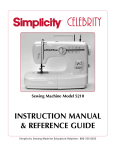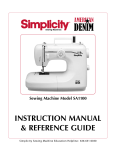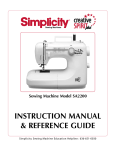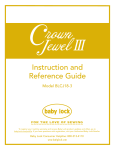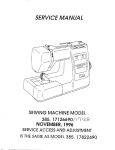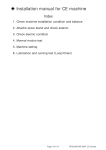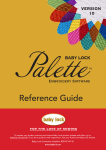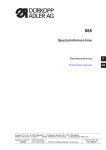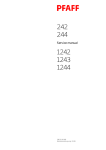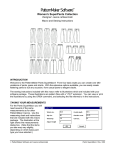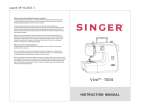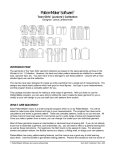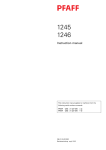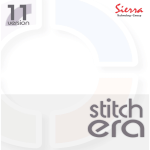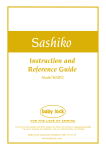Download Simplicity Pioneer II SA200 Mechanical Sewing Machine
Transcript
Sewing Machine Model SA200 INSTRUCTION MANUAL & REFERENCE GUIDE Simplicity Sewing Machine Education Helpline: 636-651-0030 IMPORTANT SAFETY INSTRUCTIONS When using the sewing machine, basic safety precautions should always be followed, including the following: READ ALL INSTRUCTIONS BEFORE USING MACHINE DANGER - To reduce risk of electric shock: 1. The sewing machine should never be left unattended when plugged in. 2. Always unplug this sewing machine from the electrical outlet immediately after using and before cleaning. 3. Always unplug before changing the light bulb. Replace bulb with same type rated 15 watts. WARNING - To reduce the risk of burns, fire, electric shock, or injury to persons: 1. Do not allow this machine to be used as a toy. Close attention is necessary when the sewing machine is used by or near children. 2. Use this sewing machine only for its intended use as described in this manual. Use only attachments recommended by the manufacturer as contained in this manual. 3. Never operate this sewing machine if it has a damaged cord or plug, if it is not working properly, if it has been dropped or damaged, or dropped into water. Return the sewing machine to the nearest authorized dealer or service center for examination, repair, and electrical or mechanical adjustment. 4. Never operate the sewing machine with any air openings blocked. Keep the ventilation openings of the sewing machine and foot controller free from the accumulation of lint, dust and loose cloth. 5. Never drop or insert any object into any openings. 6. Do not use this machine outdoors. 7. Do not operate this machine where aerosol spray products are being used or where oxygen is being administered. 8. To disconnect, turn all controls to the off position then remove the plug from the outlet. 9. Do not unplug by pulling on the cord. To unplug, grasp the plug, not the cord. 10. Keep fingers away from all moving parts. Special care is required around the sewing machine needle. 11. Always use the proper needle plate. The wrong plate can cause the needle to break. 12. Do not use a bent needle. 13. Do not pull or push the fabric while stitching. It may deflect the needle causing it to break. 14. Unplug the sewing machine when making any adjustments in the needle area, such as threading the needle, changing the needle, threading the bobbin, or changing the presser foot. 15. Always unplug the sewing machine from the electrical outlet when removing covers, lubricating, or when making any other user servicing adjustments mentioned in this instruction manual. SAVE THESE INSTRUCTIONS This sewing machine is intended for household use. 1 FORWARD WELCOME TO THE CREATIVE WORLD OF SEWING WITH SIMPLICITY! Congratulations on being the owner of a new Simplicity sewing machine. Whether you’re new to sewing, a lifelong sewer, or returning to sewing, we at Simplicity Sewing Machines are dedicated to providing you with simply the BEST features, quality, and customer service to ensure you many pleasurable hours of sewing satisfaction and success. Before starting a sewing project, here are a few recommendations to help you become acquainted with your new machine: • Read through the instruction book and become familiar with the sewing terms. • Review the machine, using the instruction book as a guide, to identify each part and function of the machine. • Practice sewing on a variety of fabric scraps using various stitches and stitch settings. • Make a stitch sampler of your favorite techniques in the instruction book, marking your machine setting preferences for future reference. • • • Thank you for choosing a Simplicity sewing machine. If you have any questions or comments, give us a call – we’ll be glad to help you! • • • Simplicity Sewing Machine Education Department 636-651-0030 2 TABLE OF CONTENTS KNOW YOUR SIMPLICITY SEWING MACHINE SEWING PRINCIPAL PARTS ............................................................4-5 SEWING TIPS ....................................................................14 ACCESSORIES .....................................................................6 BEGINNING TO SEW........................................................14 SIMPLICITY SEWING MACHINE SET-UP NEEDLE, THREAD & FABRIC GUIDE ................................15 PREPARATION FOR SEWING .............................................7 BUILT-IN STITCHES CHANGING PRESSER FEET.................................................7 STRAIGHT STITCH............................................................16 Snap-on feet.................................................................7 Seaming .....................................................................16 Screw-on feet ...............................................................7 Basting .......................................................................16 ATTACHING SEAM GUIDE .................................................7 Topstitching and edgestitching ...................................16 FREE-ARM SEWING ............................................................8 Gathering...................................................................17 ACCESSORY STORAGE .......................................................8 Zipper insertion .........................................................17 PRESSER FOOT PRESSURE REGULATOR ............................8 Piping insertion..........................................................17 DROP FEED ........................................................................8 ZIGZAG STITCH ...............................................................18 LEVELING BAR....................................................................8 Overedging ................................................................18 CUSTOM STITCH SELECTION STITCH SELECTION ............................................................9 Stitch width selector dial..............................................9 Stitch length dial ..........................................................9 Needle plate seam guides ............................................9 Reverse sewing lever....................................................9 Bartacking..................................................................18 Satin stitch for appliqué .............................................18 Attaching buttons .......................................................19 Seaming knits.............................................................19 BUTTONHOLE SEWING...................................................20 FREE-MOTION SEWING STITCH SELECTION TABLE ...............................................10 FREE-MOTION MONOGRAMMING.................................21 TENSION ADJUSTMENTS .................................................10 FREE-MOTION QUILTING ................................................21 Upper thread tension dial ..........................................10 DARNING .........................................................................21 Lower thread tension .................................................10 SPECIALTY SEWING TECHNIQUES THREADING YOUR MACHINE CHANNEL QUILTING .......................................................22 WINDING THE BOBBIN ...................................................11 HEMMING JEANS .............................................................22 LOWER THREADING ........................................................12 SEWING WITH TWO THREADS........................................22 Removing the bobbin.................................................12 Inserting new bobbin .................................................12 Placing bobbin case in shuttle ...................................12 UPPER THREADING..........................................................13 Raising the bobbin thread ..........................................13 CARE AND MAINTENANCE NEEDLES ...........................................................................23 CLEANING FEED TEETH AND SHUTTLE AREA.................23 CHANGING THE LIGHT BULB .........................................23 OILING .............................................................................23 TROUBLESHOOTING .................................................24-25 3 KNOW YOUR SIMPLICITY SEWING MACHINE O O O OO 2 3 4 5 6 FRONT VIEW O 7 O 1 O O 15 14 O O O O O 8 13 12 11 10 O 9 O O 16 20 O 17 O O 19 18 BACK VIEW 4 KNOW YOUR SIMPLICITY SEWING MACHINE FRONT VIEW O 1 O 2 O 3 O 4 O 5 O 6 O 7 O 8 O 9 O 10 O 11 O 12 FACE COVER Opens to provide access to the light bulb and the presser foot pressure regulator. BOBBIN WINDING TENSION DISC Used when threading machine for bobbin winding. O THREAD TENSION DIAL Controls the upper thread tension for proper stitch formation. O REVERSE LEVER Press this lever down and hold in place to sew in reverse. O 13 14 15 STITCH WIDTH SELECTOR DIAL Sets the width of a stitch. BOBBIN WINDER SPINDLE Winds thread on a bobbin for lower threading. HAND WHEEL Turn the hand wheel toward you to raise the needle up and down. O 16 O 17 O 18 O 19 FEED TEETH (FEED DOGS) The metal teeth under the needle plate that push or feed the fabric through the machine. O 20 PRESSER FOOT Holds the fabric firmly against the feed teeth for proper feeding. NEEDLE PLATE Supports the fabric while sewing. Has seam guide markings on right side. PRESSER FOOT THUMB SCREW Secures the presser foot or presser foot holder to the presser foot bar. NEEDLE CLAMP SCREW Loosen to remove a needle; tighten to secure a needle in position. BACK VIEW STITCH LENGTH DIAL Sets the length of the stitch. FREE-ARM COVER/ACCESSORY STORAGE Provides a flat surface for most sewing. Remove it to convert to free-arm sewing. PRESSER FOOT HOLDER Holds the snap-on presser foot in sewing position. The presser foot holder is removed when using screw-on feet. CARRY HANDLE Simply lift to carry the Simplicity sewing machine from one place to another. PRESSER FOOT LEVER Lift to raise the presser foot and release the thread tension; lower to lower the presser foot and engage the thread tension. POWER CORD RECEPTACLE Connect the three-prong power plug here. MAIN SWITCH Turns the main power and built-in sewing light on or off. RETRACTABLE SPOOL PINS Raise the spool pins to hold the spools of thread. 5 KNOW YOUR SIMPLICITY SEWING MACHINE ACCESSORIES The SIMPLICITY sewing machine comes with the presser feet and accessories you will need, conveniently stored in the free arm cover. This low shank machine uses snap-on or screw-on presser feet. O 1 1 O 3 O 2 O O 2 O 3 O 4 5 O O 4 O 5 O 6 6 O O 7 O 8 7 O O 9 8 O 10 9 O 6 O 10 O ALL-PURPOSE FOOT - snap-on Use for most straight and zigzag seams. The needle opening is rectangular to accommodate the swing of the needle in a zigzag stitch. BUTTON ATTACHING FOOT - snap-on Holds flat buttons secure for machine stitching in place. OPEN TOE SATIN STITCH FOOT - snap-on Satin stitching glides comfortably under the sole of this foot and the open toe provides clear visibility of stitches. ZIPPER FOOT - screw-on Adjusts to stitch close to either side of the zipper without catching the zipper coil. SEAM GUIDE Use to sew evenly spaced, parallel rows of stitching. PLASTIC BOBBINS (10) Hold lower thread. These are “Class 15” bobbins. SEAM RIPPER Use to remove stitching and to open buttonholes. SCREWDRIVER Use to loosen and tighten the presser foot thumb screw, needle clamp screw, and needleplate screw. FELT CUSHIONS (2) Fit on the spool pin beneath the thread spool, stabilizing the spool and preventing the thread from wrapping around the spool pin. NEEDLES (5) The most commonly used “universal” needles, size #11 and #14, are included. This machine uses 15x1 household sewing machine needles. SIMPLICITY SEWING MACHINE SET-UP The Simplicity sewing machine has many conversion options for a multitude of sewing applications. PREPARATION FOR SEWING on/off Fig. 1 Fig. 2 The power cord and foot control are one unit. Insert the three-prong plug into the machine [Fig. 1]. Insert the power supply plug into a wall outlet. Turn the power switch to “on” [Fig.1]. Raise the left retractable thread spool pin for most sewing [Fig. 2]. Raise both the left and right retractable thread spool pins for twin needle or dual thread sewing. CHANGING PRESSER FEET Fig. 3 Fig. 4 Fig. 5 Fig. 6 Fig. 7 Fig. 8 Your Simplicity sewing machine comes with both snapon and screw-on presser feet. They're easy to change and each foot helps make a specific sewing task easier. Removing and Attaching Snap-on Presser Feet 1. Turn the handwheel toward you [Fig. 3] to bring the needle to its highest position. 2. Raise the presser foot lever [Fig. 4]. 3. Release the foot by pushing the presser foot release lever located behind the presser foot holder [Fig. 5]. 4. Place the desired foot on the needle plate, aligning the metal bar on the presser foot with the groove of the presser foot holder [Fig. 6]. 5. Lower the presser foot lever to snap the foot in place. Removing and Attaching Screw-on Presser Feet 1. Loosen the thumb screw located on the left side of the presser foot on the presser foot bar [Fig. 7]. You may need to use the screwdriver. It is not necessary to remove the screw all the way. 3. Remove the presser foot holder and foot [Fig. 8]. 4. Attach the desired screw-on presser foot onto the presser bar. 5. Tighten the thumb screw with the screwdriver to hold the presser foot securely in place [Fig. 9]. Note: After attaching a presser foot, select the desired stitch and turn the hand-wheel toward you several times to make sure the needle clears the opening in the foot. Some presser feet require a straight or narrow width stitch only. ATTACHING SEAM GUIDE Insert the guide, from right to left, through the small hole near the back of the presser foot holder [Fig. 10]. Fig. 9 Fig. 10 7 SIMPLICITY SEWING MACHINE SET-UP OPTIONS FREE-ARM SEWING/ACCESSORY STORAGE Free arm sewing makes it easy to sew hard-to-reach areas such as sleeves, pant legs, and necklines. To convert to free arm sewing, grasp the left end of the free-arm cover and pull it out to the left to remove [Fig. 1]. Slip the sleeve or pant leg on the free arm as shown and sew [Fig. 2]. Accessories and presser feet are conveniently stored in the free-arm cover [Fig.3]. Fig. 1 Fig. 2 Fig. 3 Fig. 4 Fig. 5 Fig. 6 Fig. 7 Fig. 8 PRESSER FOOT PRESSURE REGULATOR The pressure on the presser foot can be adjusted for sewing on various weights of fabric to ensure proper fabric feeding and eliminate skipped stitches. 1. Open the face cover [Fig. 4]. 2. Move the lever until the desired number is displayed in the opening of the lever [Fig. 5]. Standard setting is 2 for most sewing. To increase pressure, move to a higher number. To decrease pressure, move to a lower number. Set lever at 1 for heavyweight fabrics. Set lever at 2 for mediumweight fabrics. Set lever at 3 for lightweight fabrics. Set lever at 0 for darning and free-motion sewing. DROP FEED The drop feed mechanism lowers the feed teeth below the needleplate for darning, free-motion embroidery, monogramming and free-motion quilting. This eliminates the need to make stitch length adjustments. When the feed teeth are lowered, the fabric is guided by hand, allowing free movement of the fabric in any direction. 1. Turn the handwheel toward you to raise the needle to its highest position. 2. Open the face cover and set the presser foot pressure regulator to 0. 3. Remove the free arm cover and open the front bobbin cover [Fig. 6]. 4. Push down on the drop feed lever and the feed teeth will drop below the needle plate [Fig. 7]. 5. Push the lever up to return to normal sewing. LEVELING BAR If the machine is not sitting on a level surface, turn the leveling screw to stabilize the machine. 1. Remove the free arm to access the screw under the leveling bar [Fig. 8]. 2. Turn the screw to the right to lower the machine. Turn the screw to the left to elevate the machine. 8 SIMPLICITY CUSTOM STITCH SELECTION Each built-in stitch can be customized for specific sewing needs by making stitch length and stitch width adjustments. The machine is color-coded for easy stitch length and width selection. STITCH SELECTION STITCH WIDTH SELECTOR DIAL [Fig. 1] The stitch width selector dial is numbered 0 - 5, representing the various stitch widths in millimeters. The higher the number, the wider the stitch. To select a stitch width turn the dial until the desired width setting is aligned with the indicator dot. Fig. 1 STITCH LENGTH DIAL [Fig. 2] The stitch length dial is numbered 0 - 4 representing the various stitch lengths in millimeters. The higher the number, the longer the stitch. To select a stitch length turn the dial until the desired length setting is aligned with the indicator dot. When set at 0 the fabric will not feed under the foot. Fig. 2 ⁄ ⁄ ⁄ ⁄ 1” 1 ” 5 ” 3 ” 7 ” 2 8 4 8 NEEDLE PLATE SEAM GUIDES [Fig. 3] The five seam guide markings on the right side of the needle plate are set at 1/8” intervals. The first mark is 1/2" from the needle; the second, 5/8” and so on. Align the fabric edge at a seam guide marking for a consistent seam width. The standard seam allowance width is 5/8”. REVERSE SEWING LEVER [Fig. 4] Use the reverse sewing lever to secure the beginning and ends of seams. With the foot control depressed, push and hold the reverse lever down to sew in reverse. Release the lever to return to forward sewing. Fig. 4 Fig. 5 9 SIMPLICITY BASIC STITCH SELECTION STITCH Straight Zigzag Bartack Zipper Appliqué Monogram Buttonhole Button STITCH WIDTH 0 0.5-5 4-5 0 3-5 4-5 2-5 4-5 STITCH LENGTH 1-4 1-4 n/a 3 1 n/a 0.5-1 n/a PRESSER FOOT Any Zipper Open Toe None Open Toe Button Attaching Up Up Down Up Down All-Purpose All-Purpose Open Toe DROP FEED Up Up Down TENSION ADJUSTMENTS The upper thread tension dial controls the amount of needle thread delivered to the bobbin case. Most thread tension adjustments should be made using the upper thread tension dial. In some cases, the lower thread tension on the bobbin case may need to be adjusted for specialty sewing techniques. UPPER THREAD TENSION The numbers 0-9 on the dial represent upper thread tension settings. The higher the number, the stronger the upper tension. Tension settings between 3-5 are most commonly used [Fig. 1]. In a balanced stitch, needle thread and bobbin thread interlock in the center of the two fabric layers [Fig. 2]. If needed, adjust an unbalanced stitch by turning the dial until the new setting is aligned with the indicator line on the machine [Fig. 1]. If the fabric gathers or the threads break, the upper thread tension is too tight [Fig. 3]. Loosen the tension by moving the dial to a lower number. If loops form on the under side of the seam then the upper tension is too loose [Fig. 4]. Tighten the upper tension by turning the dial to a higher number. LOWER THREAD TENSION The lower thread tension can be adjusted by turning the screw on the bobbin case slightly to the right (clockwise) to increase the tension [Fig. 5]. Turn the tension slightly to the left (counterclockwise) to decrease the tension [Fig. 6]. 10 Fig. 1 Upper thread too tight Fig. 3 Increase tension Fig. 5 Fig. 2 Upper thread too loose Fig. 4 Decrease tension Fig. 6 THREADING YOUR SIMPLICITY SEWING MACHINE For best sewing results, use a top quality, long staple, polyester or poly/cotton thread for all-purpose sewing. Skipped stitches, broken threads, and poor stitch quality are often a result of using old or inferior thread. Use the same type of thread for both upper and lower threading for a consistent stitch quality. WINDING THE BOBBIN Fig. 1 Fig. 2 Fig. 3 Fig. 4 Fig. 5 Fig. 6 Fig. 7 Fig. 8 1. To release the clutch for bobbin winding, pull out the handwheel until it clicks [Fig. 1]. 2. Place a spool of thread on the spool pin and bring the thread around the bobbin winding tension disc as shown [Fig. 2]. 3. Place the thread end through a small hole in the bobbin from the inside to the outside [Fig. 3]. 4. Place the bobbin on the bobbinwinder spindle matching the small groove on the bobbin with the spring on the spindle [Fig. 4]. Push the spindle to the right [Fig. 5]. 5. Hold the end of the thread [Fig. 6] and depress the foot control [Fig. 7]. When the thread has wound on the bobbin several times, stop the machine and clip the thread end close to the hole in the bobbin [Fig. 8]. Depress the foot control again to continue winding the bobbin. 6. When the bobbin is fully wound, stop the machine. Push the bobbinwinder spindle to the left, clip the thread and remove the bobbin [Fig. 9]. 7. Reengage the clutch by pushing the handwheel until it clicks into place [Fig. 10]. Fig. 9 Fig. 10 11 THREADING YOUR SIMPLICITY SEWING MACHINE LOWER THREADING Removing the bobbin from the bobbin case: 1. Turn the handwheel toward you to raise the needle to its highest position. 2. Remove the free-arm cover and open the bobbin cover [Fig. 1]. 3. Open the hinged latch of the bobbin case and pull the bobbin case out of the machine [Fig. 2]. 4. Release the latch to remove the bobbin [Fig. 3]. Inserting a new bobbin: 1. Hold the bobbin case in your left hand. Hold the filled bobbin in your right hand [Fig. 4]. Unwind about six inches of thread, making certain the thread unwinds over the top of the bobbin as illustrated. Place the bobbin in the bobbin case. 2. With the bobbin in the bobbin case, pull the thread into the slot on the edge of the bobbin case [Fig. 5]. 3. Pull the thread under the tension spring and into the thread outlet [Fig. 6]. Leave about six inches of thread extending from the bobbin case. Note: It’s important to be sure the bobbin is turning CLOCKWISE [Fig. 7] as you pull thread from the bobbin case. If it is turning counterclockwise, remove the bobbin from the case, turn the bobbin over, place it back into the case, and rethread the bobbin case. Placing the bobbin case into the shuttle: 1. Open the latch of the bobbin case and hold it with the long finger pointing upward [Fig. 8]. Place the bobbin case over the pin of the shuttle aligning the long finger with the notch at the top of the shuttle [Fig. 9]. 2. Release the latch and push the bobbin case firmly into place [Fig. 10]. Close the bobbin cover. Note: Be sure the bobbin thread (about six inches) falls loose from the bobbin case and is not caught or tangled in any way. 12 Fig. 1 Fig. 2 Fig. 3 Fig. 4 Fig. 5 Fig. 6 CLOCKWISE Fig. 7 Fig. 8 Fig. 9 Fig. 10 THREADING YOUR SIMPLICITY SEWING MACHINE UPPER THREADING Fig. 1 Threading Diagram Fig. 2 Fig. 4 Fig. 5 Fig. 6 Fig. 7 Fig. 9 Fig. 10 Fig. 11 Fig. 3 Fig. 8 1. Turn the handwheel toward you to raise the take-up lever to its highest position [Fig. 1]. 2. Raise the presser foot to release the thread tension [Fig. 2]. 3. Place felt cushion on spool pin. Place a spool of thread on the spool pin with the thread coming from the back of the spool [Fig. 3]. 4. Snap the thread into the first thread guide at the top of the machine [Fig. 4]. 5. Bring the thread down between the tension discs [Fig. 5]. 6. Bring the thread down the right slot of the threading path, then across to and up the left slot [Fig. 6]. 7. Bring the thread through the take-up lever from right to left [Fig. 7], making sure the thread falls into the take-up lever slot [Fig. 8]. 8. Bring the thread back down the left slot of the threading path [Fig. 9] and into the thread guide above the needle [Fig. 10]. 9. Thread the needle eye from front to back [Fig. 11]. (Clip the thread end with sharp scissors for easier needle threading.) Raising the bobbin thread 1. Make sure the presser foot lever is raised. 2. Hold the end of the needle thread with your left hand. Turn the hand wheel toward you with your right hand until the needle goes down once and comes back up, stopping when the needle is at its highest position. 3. Gently pull up on the needle thread [Fig. 12]. The bobbin thread, looped around the needle thread, will be drawn up through the needle hole. 4. Pull about six inches of both the upper and lower threads toward the back of the machine, placing them under the presser foot [Fig. 13]. Fig. 12 Fig. 13 13 SEWING Several synchronized parts of the sewing machine interact to form a stitch. The needle moves up and down as the shuttle spins in perfect time so that the bobbin thread interlocks with the needle thread through the layers of fabric. To maintain this perfectly tuned timing, here are a few sewing tips you'll want to follow: SEWING TIPS • Always begin sewing with the needle in the highest position. Always place the needle in the highest position at the end of a seam before removing the fabric from the machine. • Always turn the handwheel toward you, not away from you. Never “rock” the handwheel. • Be sure to lower the presser foot before sewing to engage the tension discs for perfect stitch balance. This is an easy step to miss when sewing extra thick fabrics. • Gently guide the fabric as you sew; never push or pull the fabric under the needle. • Don't sew over pins. Simply remove the pins as they approach the needle. Sewing over pins can damage your machine, nick the needle or cause personal injury. • Use the proper needle/thread/fabric combination. See chart on page 15. Fig. 1 Fig. 2 BEGINNING TO SEW 1. Select a stitch. Make the appropriate stitch width and length adjustments. 2. Turn the hand wheel toward you to raise the needle to its highest position. 3. Raise the presser foot and pull about six inches of thread to the back of the machine and under the presser foot. 4. Place the fabric under the presser foot aligning the cut edge of the fabric with the seam guide marking on the needle plate. Position the fabric so the needle is about 3/8” from the beginning fabric edge [Fig. 1]. 5. Lower the presser foot and depress the foot controller to begin sewing. The sewing speed is determined by the amount of pressure you apply to the foot controller. 6. To secure the beginning of a seam, take 3-4 stitches forward, then push down and hold the reverse lever to take 3-4 stitches in reverse. 7. Release the lever and continue sewing forward at a consistent speed while guiding the fabric along the seam guide marking. 8. At the end of the seam, press and hold the reverse lever to take 3-4 backstitches to secure the seam end. 9. Before removing the fabric raise the needle to the highest position [Fig. 2]. 14 Fig. 3 Fig. 4 10. Raise the presser foot and gently pull the fabric to the left, releasing at least six inches of thread from needle and bobbin [Fig. 3]. 11. Use the thread cutter on the back of the presser foot bar to cut both threads close to the fabric [Fig. 4]. SEWING NEEDLE, THREAD & FABRIC GUIDE Knit Fabrics NEEDLE STYLE NEEDLE SIZE Lightweight: Tricot Universal or Ballpoint 9/65, 10/70 Medium: Interlock, Lycra Universal or Ballpoint 11/75, 12/80, 14/90 Heavyweight: Double Knit, Velour Universal or Ballpoint 12/80, 14/90 Fake Furs, Napped Fabrics Universal or Ballpoint 14/90, 16/100 NEEDLE STYLE NEEDLE SIZE Woven Fabrics Sheer: Chiffon, Fine Lace, Tulle, Georgette, Net, Organdy, Organza Universal 8/60, 9/65 Lightweight: Batiste, Chambray, Voile, Crepe de Chine, Silk Jersey, Handkerchief Linen, Sheer Crepe Universal 9/65, 10/70 Medium Lightweight: Challis, Gingham, Taffeta, Percale, Wool Crepe, Wool Jersey Universal 11/75 Medium Weight: Broadcloth, Chintz, Velour, Corduroy, Crepe Backed Satin, Faille, Flannel, Linen, Velvet, Pique, Poplin, Satin, Shantung, Velveteen Universal 12/80 Medium Heavyweight: Brocade, Denim, Felt, Flannel, Fleece, Gabardine, Quilted Fabrics, Textured Linen, Tweed, Twill Universal 14/90 Heavyweight: Double-faced Wool, Fake Fur, Heavy Coating, Sail Cloth, Ticking Universal 16/100 Leather NEEDLE STYLE Ultrasuede, Ultra Leather NEEDLE SIZE Stretch 11/75 Vinyl Leather Point 14/90 Vinyl with Knit Backing Leather Point 14/90 Light to Medium Weight Leather Leather Point 12/80 Heavy Leather Leather Point 16/100, 18/110 15 BUILT-IN STITCHES STRAIGHT STITCH SEAMING Use for seaming two or more layers of fabric together. STITCH WIDTH STITCH LENGTH PRESSER FOOT 0 2.5-3.5 All-purpose Align the fabric edge with the seam guide marking on the needle plate and begin sewing [Fig. 1]. Take a few stitches in reverse (backstitch) to secure the seam. Continue stitching forward at a consistent speed, while guiding the fabric along the seam guide marking. Backstitch at the end of the seam [Fig. 2]. Use a shorter stitch length (2-3) when patchwork piecing [Fig. 3] or sewing sheer fabrics. Use a longer stitch (3.5-4) when sewing heavy, thick, or napped fabrics such as denim, polar fleece, or velvet [Fig. 4]. BASTING Use a basting stitch to sew temporary seams. It is ideal to use when you need to test fit a garment before sewing the seams permanently. STITCH WIDTH STITCH LENGTH PRESSER FOOT 0 4 All-purpose Align the fabric edge with the seam guide markings and sew at a consistent speed. Do not backstitch at the beginning or end of the seam. After completing the permanent seam, pull the basting stitch bobbin thread to remove the basting stitches [Fig. 5]. Fig. 1 Fig. 2 Fig. 3 Fig. 4 Fig. 5 Fig. 6 TOPSTITCHING and EDGESTITCHING Embellish a garment or special project with topstitching. Use a contrasting thread color for extra dimension. STITCH WIDTH STITCH LENGTH PRESSER FOOT 0 3 All-purpose To topstitch, align the finished edge of the fabric with the right edge of the presser foot. Lower the foot and sew [Fig. 6]. To edgestitch, place the fabric so the needle is 1/8” from the finished fabric edge. Lower the foot and sew [Fig. 7]. 16 Fig. 7 BUILT-IN STITCHES STRAIGHT STITCH GATHERING Create beautiful ruffles and flounces with the gathering technique. Fig. 1 Fig. 2 STITCH WIDTH STITCH LENGTH PRESSER FOOT 0 4 All-purpose Sew a row of basting stitches 1/4” away from the fabric edge. Sew a second row of basting stitches 1/2” away from the fabric edge [Fig. 1]. Do not backstitch. Gently pull the bobbin thread from the underside of the fabric [Fig. 2]. Adjust gathers evenly by pushing the fabric along the stitching. ZIPPER INSERTION The zipper foot is designed to allow you to sew close to raised edges. Easily and accurately insert zippers and covered cording or piping in seams using the zipper foot. Fig. 3 Fig. 5 Fig. 7 Fig. 4 Fig. 6 STITCH WIDTH STITCH LENGTH PRESSER FOOT 0 3 Zipper Remove the presser foot holder. Attach the zipper foot to the presser foot bar. Raise the needle to the highest position. The foot can be adjusted to the left or right side of the needle by loosening the screw on the foot, sliding the foot and re-tightening the screw [Fig. 3]. To sew the right side of the zipper, adjust the zipper foot so it is on the right side of the needle and the needle clears the notch on the left side of the zipper foot [Fig. 4]. To sew the left side of the zipper, adjust the zipper foot so it is on the left side of the needle and the needle clears notch on the right side of the zipper foot [Fig. 5]. Use the straight stitch ONLY with this foot. PIPING INSERTION Add decorative detail to home decorating projects and create designer fashion looks by inserting covered cord or purchased piping within seams. STITCH WIDTH STITCH LENGTH PRESSER FOOT 0 3-4 Zipper Attach the zipper foot and adjust the sliding foot to the right side of the needle. Baste the cord or piping to the right side of one fabric piece along the seamline, using the longest stitch length setting of 4 [Fig. 6]. Place the second layer of fabric with the first layer, right sides together. Shorten the stitch length to 3 and stitch the seam close to the piping [Fig. 7]. 17 BUILT-IN STITCHES ZIGZAG STITCH OVEREDGING The zigzag stitch is handy for overedging facings, hems, and seam allowances to minimize raveling. STITCH WIDTH STITCH LENGTH PRESSER FOOT 3-5 2 All-purpose Position the fabric under the presser foot so the right swing of the stitch forms just inside the edge of the fabric [Fig. 1]. Test the position by turning the handwheel toward you and manually "walking" the needle before you begin sewing. Sew, guiding the fabric evenly. Fig. 1 BARTACKING This stitch is excellent for reinforcing pocket corners and belt loops. Because the feed teeth are lowered, there is no need to make stitch length adjustments. STITCH WIDTH DROP FEED PRESSER FOOT 4-5 Lowered All-purpose Fig. 2 Bartacking Fig. 3 Fig. 4 Determine the location for the bar tack and position the fabric under the needle. Sew 4-6 stitches [Fig. 2]. Raise the needle to its highest position. Turn the stitch width dial to 0 and sew 3-4 stitches to secure the stitch. SATIN STITCH for APPLIQUÉ Use this popular, zigzag stitch creatively to sew appliqués. STITCH WIDTH STITCH LENGTH PRESSER FOOT 3-5 0.5-1 Open Toe Fuse a fabric appliqué shape to a base fabric. Place a stabilizer beneath the base fabric [Fig. 3]. Satin stitch around the cut edges of the appliqué shape guiding the fabric so the right swing of the stitch falls just over the appliqué edge and into the base fabric [Fig. 4]. Appliqué 18 BUILT-IN STITCHES ZIGZAG STITCH ATTACHING BUTTONS Use this foot to quickly and securely attach flat buttons. Fig. 1 Fig. 2 Fig. 3 Fig. 4 STITCH WIDTH DROP FEED PRESSER FOOT 5 Lowered Button Attaching Attach the button sewing foot. Set the stitch width to 0. Position the button and fabric under the foot. Position the needle over the left hole [Fig. 1]. Turn the handwheel to make sure the needle clears the hole, and sew several stitches to secure threads. Turn the stitch width dial to 5 and reposition the fabric and button to the left slightly so the needle is again aligned with the left hole. Turn the handwheel to make sure the zigzag stitch clears the holes of the button [Fig. 2]. Adjust the stitch width, if needed. Sew 8-10 stitches [Fig. 3]. To secure the stitches, set the stitch width to 0, reposition the needle over the button hole and sew a few stitches. Remove the fabric and button from the machine and clip the threads [Fig. 4]. SEAMING KNITS A narrow zigzag stitch is very flexible and durable making it suitable for medium to lightweight knit fabrics. Fig. 5 Seaming knits STITCH WIDTH STITCH LENGTH PRESSER FOOT 1.5 2-3 All-purpose Align the edge of the fabric with the seam guide markings on the needle plate and sew the seam being careful not to stretch the fabric as you sew [Fig. 5]. 19 BUTTONHOLE SEWING ZIGZAG STITCH BUTTONHOLES Make simple bartack buttonholes with the Simplicity Pioneer II. STITCH WIDTH STITCH LENGTH PRESSER FOOT 1.5 and 5 0.5-1 Open Toe 1. Mark the location of buttonhole on your garment [Fig. 1]. 2. Attach the open toe foot. Set the stitch length dial to the buttonhole mark between 0 and 1 [Fig. 2]. 3. Position the fabric under the presser foot so the first bartack marking is just under the needle and the center mark is centered under the foot [Fig. 3]. Set the stitch width dial to 5. Sew 6-7 stitches. Stop with the needle in the right side of the bartack stitch [Fig. 4]. 4. Raise the presser foot and set the stitch width dial to 1.5. This will also move the fabric slightly to the left. Lower the foot and sew the right leg of the buttonhole, stopping at the second bartack marking. Stop with the needle in the right side of the stitch [Fig. 5]. 5. Raise the presser foot and set the stitch width dial to 5. Lower the foot and sew 6-7 stitches. Stop with the needle in the left side of the bartack stitch [Fig. 6]. 6. Raise the presser foot and set the stitch width dial to 1.5. Lower the foot and hold down the reverse sewing lever to sew the left leg of the buttonhole [Fig. 7], stopping at the first bartack [Fig. 8]. 7. Raise the needle to the highest position and raise the presser foot. Remove the fabric and trim the thread ends near the stitching. Using the seam ripper, carefully cut an opening in the middle of the buttonhole [Fig. 9]. Be careful not to cut any stitches. You may want to put a straight pin across both ends of the buttonhole to help prevent cutting the buttonhole bartacks. Fig. 1 Fig. 2 Fig. 3 Fig. 4 Fig. 5 Fig. 6 Fig. 7 Fig. 8 Fig. 9 20 FREE-MOTION SEWING Darning or free-motion sewing and quilting are easily accomplished by lowering the feed teeth and removing the presser foot and presser foot holder [Fig. 1]. This allows “free” movement of the fabric in any direction. There is no need to adjust the stitch length because you will actually be guiding the fabric movement. Use freemotion sewing to monogram, embroider, quilt, or darn. FREE-MOTION MONOGRAMMING Fig. 1 Fig. 3 Fig. 2 Fig. 4 STITCH WIDTH DROP FEED PRESSER FOOT 4-5 Lowered None Mark the letter or letters to be monogrammed on the fabric with a wash-out marker. Place the fabric and stabilizer into a machine embroidery hoop. Raise the needle to its highest position and slide the hoop under the needle. Lower the presser foot lever. To lock the stitching, set the width at 0, hold the needle thread in the left hand and turn the hand wheel toward you to draw up the bobbin thread [Fig. 2]. Holding threads firmly, take three to five stitches in one spot. Set the stitch width to 5. Begin sewing at a medium speed. Move the hoop left to right, forward and backward, following the marked letter [Fig. 3]. FREE-MOTION QUILTING Fig. 5 Note: Relax your shoulders and breathe while you work. Place hands firmly around the hoop, using your index and middle fingers to guide the fabric. Be sure to lower the presser foot lever before sewing! STITCH WIDTH DROP FEED PRESSER FOOT 0 Lowered None Baste or pin-baste the fabric, batting, and backing together. It is not necessary to place this in a hoop. Select a design already in the fabric or transfer your own design using a template. Continue with the directions above following the design line [Fig. 4]. DARNING STITCH WIDTH DROP FEED PRESSER FOOT 3-5 Lowered None Place a stabilizer under the hole or tear. Place the fabric under the foot. Lower the foot and sew, moving the fabric from left to right and up and down until the hole is completely covered [Fig. 5]. Use a thread to match the fabric color for a nearly invisible mend. 21 SPECIALTY SEWING TECHNIQUES CHANNEL QUILTING Quilt fabrics using the seam guide to sew evenly spaced, parallel rows of stitching. STITCH WIDTH STITCH LENGTH PRESSER FOOT 0 3 All-purpose w/sewing guide Insert the seam guide into the presser foot holder (see page 7). Set the guide the desired distance from the needle by sliding it to the right or left. After sewing a row of stitching, move the fabric to the right, placing the curved arm of the bar on the previous row of stitches [Fig. 1]. Fig. 1 HEMMING JEANS STITCH WIDTH STITCH LENGTH PRESSER FOOT 0 3-4 All-purpose The size 14 needle, included with the Simplicity sewing machine, is designed for sewing through multiple layers of heavy fabric. Use it when hemming jeans to penetrate the fabric more easily when sewing over the dense side seam. When you come to the side seam of the pant hem, place a shim (such as a piece of cardboard the same thickness as the seam) under the foot and against the seam [Fig. 2]. This levels the foot so the machine can sew through the extra thickness. Fig. 2 SEWING WITH TWO THREADS STITCH WIDTH STITCH LENGTH PRESSER FOOT 0-5 2-4 Any Create a bold look or add extra color to a stitch by sewing with two threads through the upper threading path. Use the size 14 needle which has a larger eye to accommodate two threads. Place a spool of thread on the left spool pin with the thread coming off the back. Thread the machine as usual. Place a second spool of thread on the right spool pin with the thread coming off the front [Fig. 3]. Thread the machine along the same path and through the needle eye as for the first thread. Select a stitch and sew. 22 Fig. 3 CARE and MAINTENANCE To ensure the best possible operation of your machine, it is necessary to keep the essential parts clean at all times. Disconnect the machine from the power source before performing any maintenance. NEEDLES Fig. 2 Fig. 1 Race Shuttle keepers CLEANING FEED TEETH and SHUTTLE AREA Shuttle Shuttle race cover Bobbin case Shuttle area Fig. 3 The Simplicity sewing machine uses standard sewing machine needles (15x1). The size and type of your needle should be compatible with the fabric (see page 15). Change the needle often – after every other project is a good habit. Bent or dull needles will cause skipped stitches and thread breakage. To change the needle, loosen the needle clamp screw [Fig. 1]. Remove the needle by pulling it downward [Fig. 2]. Insert the new needle by pushing it up into the shaft as far as it will go with the flat side toward the back of the machine. Tighten the needle clamp screw. Fig. 4 Raise the needle to its highest position. Remove both the needle plate screws and the needle plate [Fig. 3]. Remove the bobbin case from the shuttle. Push aside the two shuttle keepers and remove the shuttle race cover and shuttle. Clean the feed teeth and shuttle area with a lint brush [Fig. 4]. Turn the hand wheel until you see the race forming a half moon as pictured [Fig. 5]. Holding the shuttle by its center pin, place it on top of the race so that it forms a half moon on the top side [Fig. 6]. Place the shuttle race cover over the shuttle and race. Snap the shuttle keepers back into position. Replace bobbin case. Replace the needle plate and screws. CHANGING the LIGHT BULB Open the left side face cover. Turn the light bulb clockwise to unscrew and remove the bulb. Install a new bulb by turning it counter clockwise to screw it in place [Fig. 7]. Use a 15W (max.) screw-in type bulb. OILING Fig. 5 Fig. 6 Fig. 7 Fig. 8 Put 2-3 drops of sewing machine oil at each of the points indicated [Fig. 8]. Run the machine unthreaded for 30-60 seconds. Wipe off any excess oil. Oil every 7-10 hours of use. Use sewing machine oil ONLY. 23 TROUBLESHOOTING GUIDE Problem Possible Cause TOP THREAD BREAKS Machine is threaded incorrectly . . . . . Rethread machine and needle Tension is too tight . . . . . . . . . . . . . . . Reduce tension on top to a smaller number Thread is too heavy for needle size . . . Use a larger needle Needle is inserted incorrectly . . . . . . . Reinsert needle with flat side toward back Needle is damaged . . . . . . . . . . . . . . . Insert new needle Thread is caught on spool pin . . . . . . . Remove spool, unwind excess thread, clip, turn spool over, and use felt disc on spool pin LOWER THREAD BREAKS Bobbin case is not inserted correctly . . Reposition bobbin. If thread pulls smoothly, it is correct Bobbin case is improperly threaded . . . . Refer to instructions for correct threading Bobbin tension is too tight. . . . . . . . . . Change bobbin tension according to instructions SKIPPED STITCHES Needle is not inserted correctly . . . . . . Reinsert needle with flat side toward back Needle is damaged . . . . . . . . . . . . . . . Insert new needle Wrong type of needle is used . . . . . . . Match needle size to fabric and thread weight Wrong presser foot is used . . . . . . . . . Check the proper presser foot needed for specific task Foot pressure is wrong. . . . . . . . . . . . . Check foot pressure regulation for proper setting NEEDLE BREAKS Needle is damaged . . . . . . . . . . . . . . . Insert new needle Needle is not inserted correctly . . . . . . Reinsert needle with flat side toward back Fabric is too heavy/wrong needle size . . Match needle size to fabric and thread weight Fabric is being pulled during sewing . . Check for proper foot pressure; make sure feed teeth are raised and operating correctly; lengthen stitch length. Fabric should feed automatically. Pulling the fabric will throw the machine out of time. STITCHING FORMS LOOPS Needle is not threaded correctly . . . . . Thread needle from front to back Bobbin is not threaded correctly . . . . . Check instructions for proper bobbin threading Improper needle and/or thread used . . Match needle size to fabric and thread weight SEAMS SHRINK OR PUCKER Presser foot pressure is too heavy . . . . Reduce presser foot pressure to a lower number THREAD BUNCHING OR “NESTING” ON UNDERSIDE OF FABRIC Top tension is too loose. . . . . . . . . . . . Increase top tension to a higher number. Normal settings are between 3-5. Machine is not threaded correctly . . . . Rethread machine making sure presser foot is raised and the take-up lever eye is threaded. Raising the presser foot will help seat the thread between the tension discs. Bobbin case is improperly threaded . . . . Refer to instructions for correct threading Thread is of poor quality . . . . . . . . . . . Use quality thread Needle is too large for fabric . . . . . . . . Use a smaller size needle Wrong stitch length is used . . . . . . . . . Adjust length for proper stitches Top and bottom threads are not. . . . . . Draw both threads back under the presser foot and drawn back under the presser hold until a few stitches have formed foot before sewing 24 Solution TROUBLESHOOTING GUIDE Problem Possible Cause Solution IRREGULAR STITCHING AND FEEDING Thread is of poor quality . . . . . . . . . . . Use quality thread Presser foot pressure is too light . . . . . Increase presser foot pressure to a higher number Bobbin is not threaded correctly . . . . . Thread bobbin again and check for proper insertion Fabric is being pulled during sewing . . Check for proper foot pressure; make sure feed teeth are raised and operating correctly; lengthen stitch length. Fabric should feed automatically. Pulling the fabric will throw the machine out of time. MACHINE IS NOISY AND ROUGH WHEN SEWING Machine needs oil . . . . . . . . . . . . . . . . Refer to cleaning and maintenance instructions Lint and oil residue have collected . . . Clean race and hook according to instructions in hook or on needle bar Inferior oil has been used . . . . . . . . . . Clean and oil again. Use only fine sewing machine oil. Do not use WD40. Needle is damaged . . . . . . . . . . . . . . . Insert new needle Stitch length and/or width dials are set . Refer to instructions for proper machine settings incorrectly for the type of stitch used 25 1760 Gilsinn Lane Fenton, MO 63026 For Sewing Machine assistance call: Simplicity Education Department 636-651-0030 Monday-Friday 9:00 a.m. - 5:00 p.m. CT ©2002 Tacony Corporation IBSA200



























